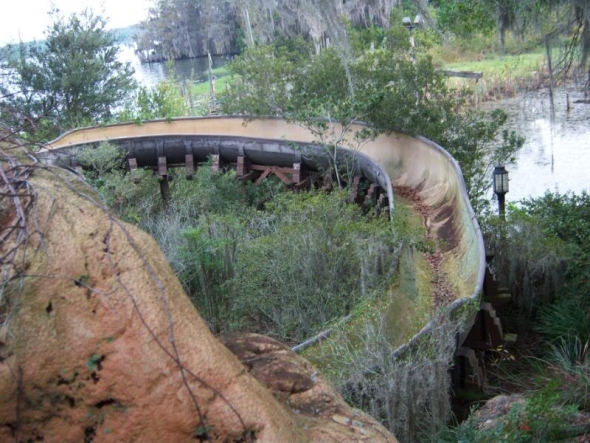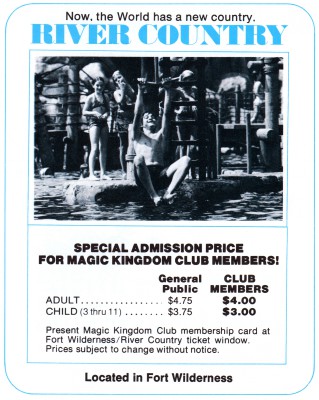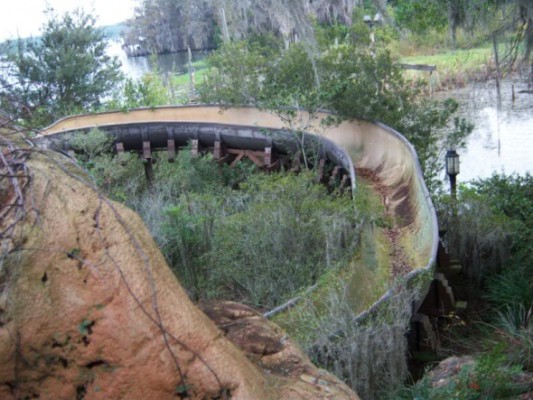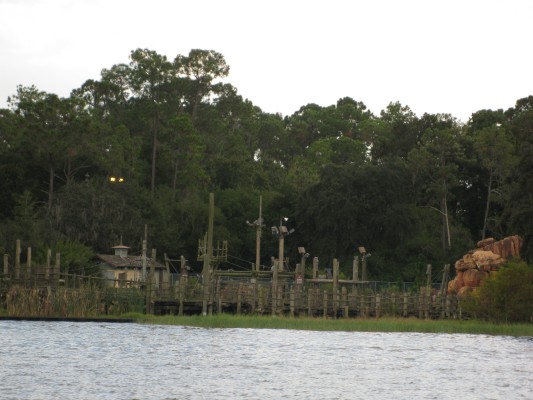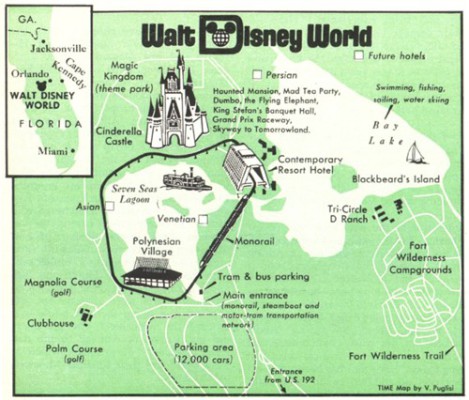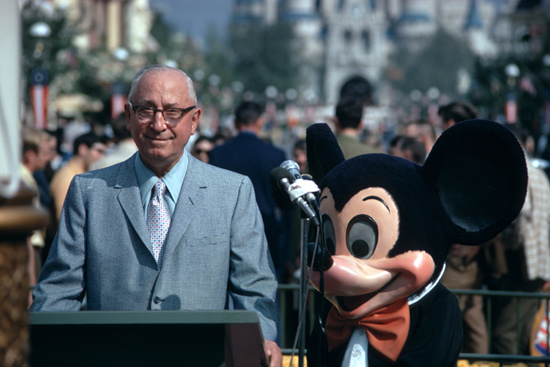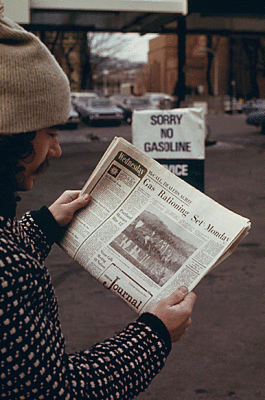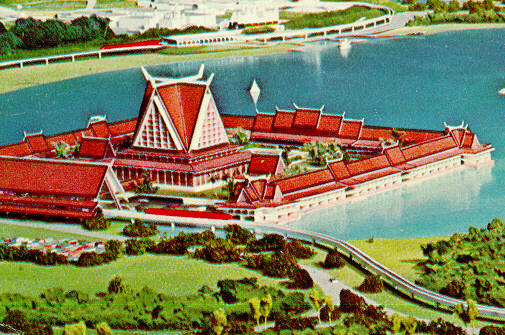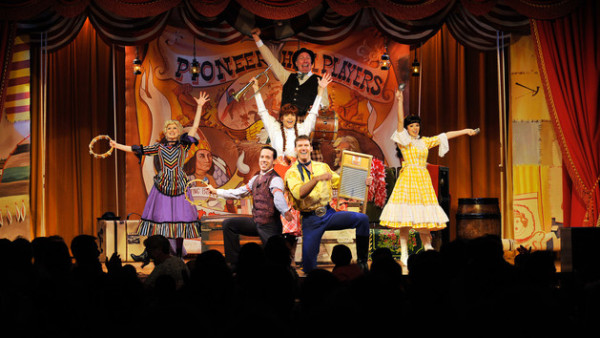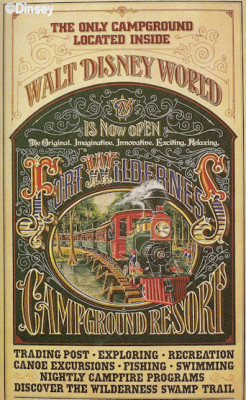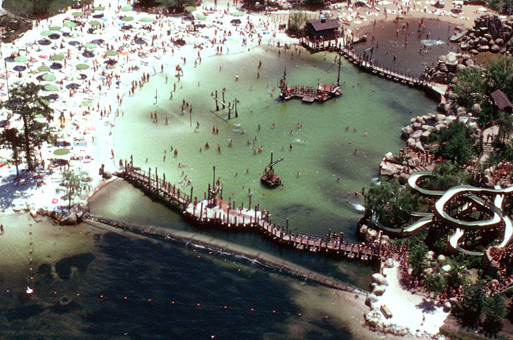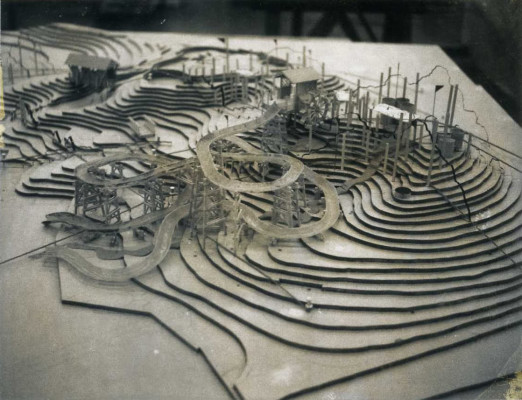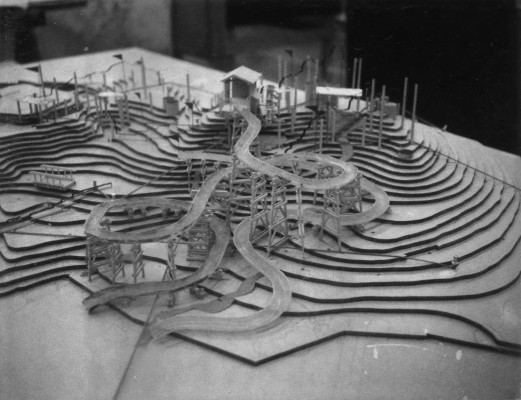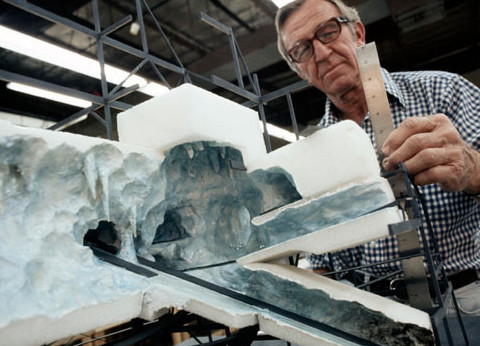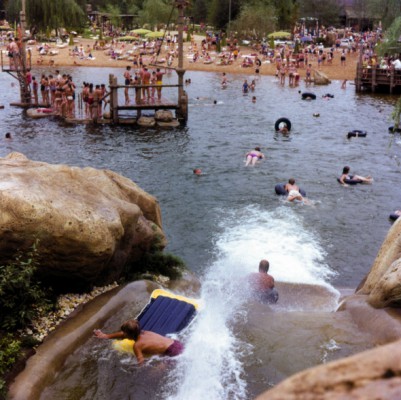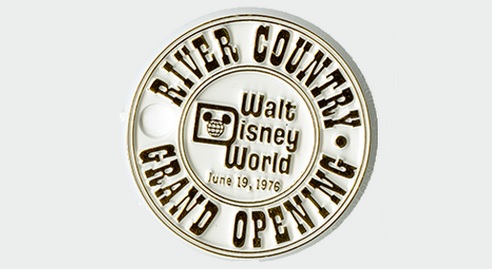“An exciting new country now awaits you inside Walt Disney World’s Fort Wilderness.”
“River Country is the kersplashingest, kid laughingest, slippery slidingest, raft ridingest, rope swingingest, swan divingest, summer swimmingest, sun snoozingest, picnickingest, old-fashioned, good, clean wet American fun you’ve ever had!”
“Bring a swimsuit and a smile. You’re likely to wear both out, at River Country.”
These were some of the words that Disney used to entice guests to visit its first ever water park, River Country, which debuted at Walt Disney World in Florida in 1976.
Sounds fun, doesn’t it?
A 1978 ad for River Country. Image – Tom Simpson, Flickr
Fast forward to today, and River Country still stands next to Bay Lake, not far from the Magic Kingdom. The slides are still in place. The pools are full of water. Safety signs advise guests of what they should and shouldn’t do.
There’s just one problem: the park is completely abandoned, and has been for more than 13 years.
The slides are gradually disappearing underneath dense plant life, and swimming in the dank pools is not advisable. In short, Disney’s River Country is decaying and dissolving, the millions of visitors that passed through its gates now a thing of the past. And it’s all happening right in front of our very eyes – parts of the park are still clearly visible from boats passing by on Bay Lake, while the entire area stands just meters away from the Fort Wilderness Resort.
The view of the abandoned River Country from Bay Lake. Image – Amanda, Flickr (taken in 2009)
How did it come to this? And why?
If you’re a Disney fan, you’ve probably heard of River Country. Striking images of its abandoned state have spread like wildfire across the web and social media in recent years, and you may even have visited the park during its 25 years in operations.
However, while photographs of the crumbling River Country are easy to come by, piecing together the full story behind it is more difficult. Why – and how – did Disney build a water park in the first place? What was it like to visit? Why did it shut down? Why didn’t Disney demolish it? And could it ever open again in the future?
The answers to these questions are out there, spread across hundreds of articles on dozens of websites. Yet, to our knowledge, no-one has pulled them together before into a single, coherent account of the rise, fall and decay of a park that many hold dear to their hearts.
Bring a swimsuit and a smile. THIS is the story of Disney’s River Country.
The beginning
These days, Walt Disney World is a vast, sprawling resort that is firmly established as one of the world’s leading tourist destinations. It boasts no fewer than four full-sized theme parks, two water parks (not counting the deserted River Country), a huge shopping and entertainment district and dozens of resort hotels.
Back in the early seventies, things were very different. Just take a look at the 1971 guide map below to get an idea of just how sparse the resort was in comparison to today:
Image via orlandoweekly.com
The Magic Kingdom was there, of course. It was largely a clone of the original Disneyland, and featured many attractions that are still favorites today, such as the Haunted Mansion. There were a handful of resort hotels, including the iconic Contemporary Resort and the exotic Polynesian Village Resort – both of which were connected to the theme park by a monorail system (note that the Venetian and Asian Resorts shown on this map never actually materialized). For those on lower budgets, camping was available at Fort Wilderness.
Roy Disney opens the Magic Kingdom in October 1971. Image © Disney
Despite concerns that an East Coast audience wouldn’t warm to Disney’s brand of tourism, the Magic Kingdom quickly became very popular following its 1971 debut. Look beyond the theme park, though, and there was precious little to do. Guests could swim, fish or sail on Bay Lake. They could play a round of golf. They might ride a horse around Fort Wilderness. At a push, they could simply glide along on the monorail. But none of those things were likely to draw them in for the long, multi-day stays that would boost Disney’s bottom line.
Of course, Disney had to start somewhere, and the plan was always to expand Walt Disney World with more attractions and more hotels. Those plans, though, were jeopardized in 1973 when war broke out in the Middle East. An oil embargo was placed on Western nations, and President Nixon scrambled to introduce gasoline rationing. For a resort that received the majority of its guests via car, this was nothing short of a disaster. Attendance at the Magic Kingdom crashed, and Disney’s share price fell by more than half.
Gas rationing was bad news for Walt Disney World. Image – David Falconer, Wikipedia
It wasn’t just Disney that was suffering. The newly-growing Central Florida tourism market that it had largely created was crashing around it, with existing hotels shutting their doors and construction work on new ones grinding to a halt.
Slowly, painstakingly, Disney turned the situation around. It adjusted its marketing to attract more locals, and put in place measures to ensure that guests coming from farther afield would be guaranteed enough gas to complete their journeys to and from the resort. It cut costs and laid off staff. And, eventually, the crowds returned. So, too, did the oil when the embargo was lifted in March 1974.
The plans for expansion, however, were permanently changed. In those days, Disney was determined to be a “good neighbor” to other businesses in the area. It considered its competitors in the tourism industry to be “supporting” rather than “competing” amusements, and had even invited Dick Pope, the owner of nearby Cypress Gardens, to the opening day of the Magic Kingdom. Similarly, it wanted to maintain good relations with the owners of the hotels and motels that had sprung up on the fringes of Walt Disney World.
Disney’s Asian Resort was a victim of changes to its hotel-building plans. Image © Disney
The Golf Hotel opened as planned in December 1973. However, plans for additional on-site accommodation in the form of the Asian Resort, the Persian Resort and the Venetian Resort were scrapped, partly to avoid antagonizing struggling local competitors. Instead, development would be focused on Fort Wilderness, which as a campground was not viewed as truly “competitive” with hotels and motels.
Any additions to Fort Wilderness could double as incentives for guests at the other hotels to stay at Walt Disney World for an extra day or two. According to David Koenig’s excellent Realityland, Disney initially considered the creation of an enormous “Wild West” village, complete with restaurants, retail outlets and other amusements. It even went as far as building the town’s Pioneer Hall, which hosted a buffet and also became home to the long-running Hoop-Dee-Doo Musical Revue show.
The Hoop-Dee-Doo Musical Revue is still running today. Image © Disney
Plans were made to rename a small island close to Fort Wilderness in the heart of Bay Lake as Treasure Island (later changed to Discovery Island). Animal exhibits were installed and it was marketed as a nature preserve. However, the Western Village plans were dropped after management decided that it would be more lucrative to create a high impact, separately-ticketed attraction that could be pitched as an essential destination for all resort guests.
Disney was going to build a water park.
The Ol’ Swimmin’ Hole
Just as there were amusement parks before Disneyland, there were water parks (or, at least, pools with slides) before River Country.
With Disneyland, however, Walt Disney had completely revolutionized the whole concept of the amusement park. Rather than simply assembling a collection of rides, Disney created an entire fantasy world (and sub-lands within it) that transported guests to other times and places. In short, Disneyland was the first true theme park.
In a similar vein, the company’s first water park wouldn’t simply host slides and swimming pools. Instead, it would feature a single, cohesive theme, and each of the attractions would be carefully designed to fit within it. In essence, it would do for water parks what Disneyland had done for theme parks. The fingerprints of River Country’s Imagineers can still be seen today at dozens of other water parks, most noticeably the ones created by Disney itself.
Fort Wilderness was Walt Disney World’s lowest-cost accommodation option. Image © Disney via AllEars.net
Naturally, as the water park was due to be placed within Fort Wilderness, it would have to match the resort’s rustic wilderness theme. As it had in the past, Disney would draw inspiration from the works of Mark Twain. Working under the title “Pop’s Willow Grove”, Imagineers settled on the concept of an “old-fashioned swimming hole” – a place where Huckleberry Finn himself might have gone for a dip.
Supporting this theme would be the park’s physical location, on a six-acre plot on the south shore of Bay Lake. Indeed, to the untrained eye it would appear as if there was really no separation at all between the natural lake and the natural-looking swimming hole next to it. In typical fashion, Disney devised a way to make sure that guests at its water park would be able to swim in the actual lake water, in a way that was as clean and safe as possible.
Water would be drawn from Bay Lake via an intake/filter pipe, being sent along the lake bottom into a pump system inside an enormous artificial mountain. From there, it would be forced down the park’s flume troughs at 8,500 gallons per minute – serving both to sweep guests down the flumes, and to continually top up the water supply in River Country.
The “bladder” separating Bay Lake from River Country’s Bay Cove can be seen clearly in this aerial image. Image © Disney
Separating the water park’s Bay Cove from Bay Lake would be a large rubber “bladder”. This would remain inflated six inches above the surface of Bay Lake with the help of a special sensor system, ensuring that filtered water could leave the park and spill over into Bay Lake, but that unfiltered water could not pollute River Country’s swimming pools.
Pat Burke, who joined Disney in 1972, was one of the Imagineers who worked on the River Country project. In a fascinating interview with Disney and More back in 2011, he revealed some of the processes behind the creation of the park.
“I worked with [architect] Dick Kline on River Country, which I believe was the first themed water park with trestle-supported slides that I know of. I remember the problem with trying to figure out the slide and its supporting trestles.”
Image – Pat Burke, via Disney and More
Whereas today’s major theme park and water park attractions are modelled extensively using computer software, things were different during River Country’s development. “We had no computers yet and I was given a flat drawing of the proposed slides,” says Burke. “Having had photography in college under Chouinard’s Jerry McMillan, I cut out the suggested elevations on the model pictured [above]. I then rolled on film emulsion under a red light, and flashed a film of the flat two-dimensional plan on it with an overhead projector.”
“We quickly developed and fixed the film, yielding a three-dimensional model to work with. I built the slides out of fiberglass, just as the real ones would be, and figured out the themed wood tower heights needed for a marble to roll down them.”
Image – Pat Burke, via Disney and More
The park’s main attractions would be centered around its faux mountain (the same one that hosted the intake pipe from Bay Lake). “The mountain was terraced,” explains Burke, “so I built the model slides from a flat plain above out of fiberglass sections I moulded and modelled off rubber hose laid in the position of the plan. They were a lot like snake skins.”
It may have been a relatively low-tech approach, but it worked. “That was a great experiment and made it very easy to lay out the course of the slide and for rockwork legend Fred Joerger to do his River Country rockwork.”
Joerger had been lured away from Warner Bros. by Walt Disney in 1953 to become one of the very first Imagineers. One of his earliest projects had been to create several models of Disneyland’s Sleeping Beauty Castle, helping Walt to settle on a final design. Over the years since those initial Disneyland projects, he had become a master of sculpting convincing fake rocks, and was responsible for almost all of the rockwork at Walt Disney World when it opened (including the iconic fountains in the Polynesian Village Resort’s lobby, which were recently removed despite protests from fans).
Imagineer Fred Joerger, pictured working on a model of Disneyland’s Matterhorn. Image © Disney via Jim Hill Media
“Clay was rarely used at WED [Disney’s Imagineering arm] back then,” explains Burke. However, Tony Baxter had used it on his model for Big Thunder Mountain Railroad, and Joerger also employed it to sculpt the rockwork around the model slides that Burke had created. He also oversaw the creation of the full-sized rocks during the park’s construction, with former colleague Harriet Burns recalling: “He just had the aesthetic ability to do it himself. What would take a whole team before, he would do overnight.” Asked himself how he produced such impressive rockwork, Joerger quipped, “You just have to learn to think like a rock.”
Just one example of River Country’s extensive rockwork. Image – Tom Simpson, Flickr
The mock rocks were scattered with real pebbles from streambeds in Georgia and the Carolinas. Guests would also be greeted by real, sandy beaches, helping to create the overall impression that this was a natural swimming hole, and not something that had been carefully hand-sculpted.
As construction work on the park proceeded, some very senior figures at Walt Disney World became intimately involved. Vice President Dick Nunis even volunteered as a “slide tester”, with Burke recalling that he “let us know which corners needed to be higher so you didn’t fly over the edge like I heard he did.”
By the end of May 1976, River Country was ready to welcome its first guests. Walt Disney World Cast Members were invited to a special “splash party” preview that ran over a six-day period, allowing the attractions to be thoroughly tested on large number of visitors, and helping to ensure that the park’s staff knew how to handle the crowds. The Cast Members and their families could also hop on a boat to visit Treasure Island, which had opened in April 1974.
A celebratory coin from River Country’s grand opening. Image © Disney
The grand opening of River Country followed in June 1976, with more than 700 reporters and their families in attendance. They were all equipped with admittance bracelets with specially-designed celebratory coins like the one pictured above.
President Ford’s 18-year-old daughter Susan helped officiate, and marked the park’s debut by plummeting down the 260-foot Whoop ‘n Holler Hollow slide into Bay Cove. River Country was open for business.
Full article: www.themeparktourist.com
